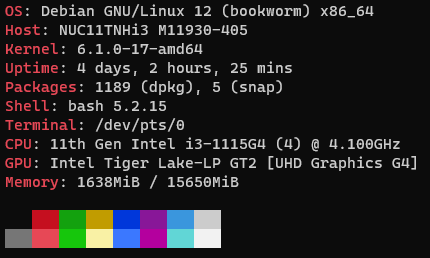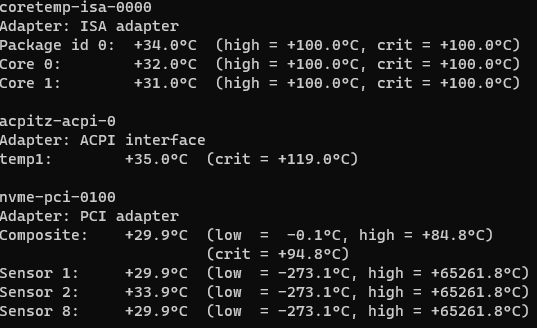- 0 Posts
- 41 Comments
Install linux somewhere, ssh to it and set up a web sever and an ftp server. Access it locally and then access it from the internet. This should be your first goal. It will make you comfortable with the command line and linux. You can try a montero node then.
ChatGPT will be able to help with the basic stuff like how to check logs, configs, or what SSH is or how to set it up.
Check the CPU, every NUC has a different one. An 11th gen i3 (i3-1115G4) will generally offer better performance than a N100 but a N100 may offer slightly better power efficiency since it was designed for it and is newer. Also when keeping in mind power draw and thermal efficiency, newer CPUs will usually do better. I personally would stear clear of older machines for that reason.
NUC is good for transcoding if you really need it. NUC11 i3 i think has 30w tdp and draws sub 10w at idle and does transcoding fine. Check specific HW codec support for your needs but stick to Intel because they will generally be the best in this space.
Also can confirm Jellyfin doesnt run well on a rpi4. No problem on a NUC.
Raspberry pi is power limited. HDD creates a power spike on boot as well so you may have power issues. When i used a rpi for a media server, i had to use a 25W supply. Even 20W wasnt enough and i had voltage throttling issues. 1TB HDD probably wont draw that much power but SSD is never an issue. If you dont need space and are on a budget SSD is the way to go. This is all assuming USB is used for power.
If you need large amounts of space and have a budget, use an HDD but it needs to be self powered or used with a larger device like a mini pc which has adequate internal power.
Self refers to oneself as in, a person. I never associate selfhosting with a company which runs their own servers. Technically they do self host but is it a company asking questions on an online forum and referring to itself as oneself? Is a company a person? What is a company even? Philosophical questions we dont have time to discuss.
To me, self hosting means a person is self hosting things. Some have racks and use 1kW of power on idle, some have micro servers. In any case, just one paragraph explaining what you have at the top of a post is sufficient to get the point of what you know across.
Id say a more important distinction is persons who self host software only (VPS) and those who do hardware as well.
I run a NUC11 so about 10W. 15-20€ per annum assuming a single tariff at 0.17€ per kwh. It can use up to 30W but only during heavy load which may be like 8 hours a week. But electricity is also cheaper during off peak hours so it averages to about that (we have 5 tariffs).
Load is NAS, media server, homeassistant and a usb zigbee router, *arr stack.
Power usage was my main concern and wanted something eco friendly.

I use nginx as a reverse proxy and assign each service either a subdomain or a specific url. SSL is configured once so all services get https. Its not the best though, some services don’t like being behind a reverse proxy or don’t play nice with the url, subdomain management can get cumbersome and if the service doesn’t have a login page, it is open to bad actors… i was thinking of making a website with login and exposing other web services through an iframe but i don’t know how viable that may be.
A vpn would probably be the best way to go from a security standpoint but accessing services may be a pain on remote devices where a vpn isn’t supported - like how would a TV on a remote network access tour jellyfin server if the service is only accessible through a vpn tunnel and the tv has no way of connecting to it? Not sure.

Yeah a lot of people will say to just use your old PC thats lying around and it is a great way to start and learn but if you want something with a lower footprint (low power, quiet, cool) you’re better off buying something more suited to that task. Laptops or mini PCs are much more suited to that.
Id love to have a server rack one day but I just cant justify it drawing so much power when I can live with the drawbacks of a smaller server.

Look into a NUC on ebay. I was able to snag a new 11th Gen i3 for 200 eur. Power draw is about 7w with a headless Debian. Running a media server, nextcloud, pihole, an arr stack and I’m planning to add home assistant and a zigbee bridge which I now run on a pi.
If you aren’t planning to run to much on it a rpi4or5 will actually be enough and these things can draw 15 on absolute max load.

Yup. My bet as well. People love to place achievements and advancements in technology on one person while in reality there’s always a team behind it. The reality is things have gotten so complex, its damn near impossible for one person to make a breakthrough themselves without building on the work of someone else or fragmenting the work and have it be done by multiple people.
I run nextcloud which has a music plugin. The plugin exposes an ampache and subsonic api. All you need now is a client. I use ultrasonic on android. This is for out of home streaming. In home both plex and jellyfin offer dlna for pretty much any networked device made in the past 15 years. That’s how I listen on an AVR. On a PC I could use that or just browse to the nextcloud music plugin and listen in browser.

It’s hard to recommend a Google product but Google TV or chromecast with Google TV does the job it’s supposed to do. App support is large and what isn’t there can be installed the same way it can be on an Android phone. I can stream Playstation games to it even though Sony doesn’t support it. Smart TV built in os’s aren’t up to par yet. At least not in the price range I’m buying my tvs.
I used two pies. Rpi3 for home assistant, pihole and zigbee+mqtt. rpi4 for arr stack and nextcloud with a 5TB disk on it. Swiched to everything in a i3 NUC 11 i got for 200eur. Works better, uses less power if you can believe it.
A note about transcoding: I dont know your setup but I never needed it. All video I have is encoded in h264 or HEVC and all my video player devices support these codecs natively. The last time I needed to transcode was 10 years ago when all I had for a media player was a Wii and a movie in HEVC.



If a security flaw is discovered and patched, it is a good sign the manufacturer is standing by their product and providing support. AFAIK, tp link does push regular fw updates for their omada gear. I’ve had two in the last month.
In your case, I’d open a support ticket with that issue and see what tp link thinks directly. If you don’t like their reply or are ignored, you will have your answer on whether or not you should switch.